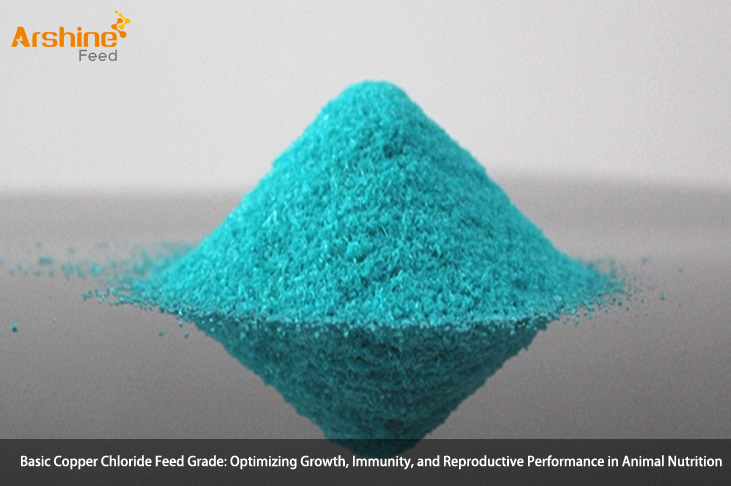

Introduction: Basic copper chloride feed grade, a bioavailable and cost-effective source of copper, has become an indispensable ingredient in modern animal nutrition and feed formulation. Recognized for its essential role in various physiological processes, including enzyme function, antioxidant defense, and connective tissue formation, basic copper chloride plays a pivotal role in enhancing growth, immunity, and reproductive performance in livestock and poultry. This comprehensive article explores the applications, benefits, and regulatory considerations of basic copper chloride feed grade, shedding light on its transformative impact on animal agriculture.
Understanding Basic Copper Chloride Feed Grade: Basic copper chloride (CuCl2∙2Cu(OH)2) is a water-soluble inorganic compound that provides bioavailable copper, a vital trace mineral required for optimal growth, development, and metabolic function in animals. In its feed-grade form, basic copper chloride undergoes rigorous purification, quality control measures, and formulation to ensure safety, efficacy, and compliance with regulatory standards for use in animal feed and feed additives.
Applications in Animal Nutrition: Basic copper chloride feed grade serves multiple functions in animal nutrition and livestock production, contributing to enhanced growth, immunity, reproductive performance, and overall well-being in various animal species. Some key applications include:
Growth Promotion and Nutrient Metabolism: Copper is an essential cofactor for numerous enzymes involved in carbohydrate metabolism, lipid synthesis, and protein synthesis, which are fundamental processes supporting growth and development in animals. Supplementation of basic copper chloride feed grade in animal diets ensures optimal copper status, promotes efficient nutrient utilization, and facilitates robust growth, thereby enhancing production efficiency and profitability in livestock and poultry production systems.
Immune System Support and Disease Resistance: Copper plays a critical role in immune system function, immune response modulation, and disease resistance by facilitating the production of immune cells, antibodies, and antioxidant enzymes. Basic copper chloride feed grade helps maintain immune system integrity, enhance immune defenses against pathogens, and reduce susceptibility to infectious diseases, thereby supporting animal health, welfare, and performance in diverse production environments.
Reproductive Performance and Fertility Enhancement: Copper is essential for reproductive performance, fertility, and embryo development in animals by supporting hormone synthesis, ovarian function, and sperm quality. Supplementation of basic copper chloride feed grade in breeding and gestating diets promotes reproductive efficiency, improves fertility rates, and enhances reproductive outcomes, including conception rates, litter sizes, and neonatal viability in livestock and poultry species.
Connective Tissue Formation and Wound Healing: Copper plays a crucial role in connective tissue formation, collagen synthesis, and wound healing by supporting the cross-linking of collagen fibers and facilitating tissue repair processes. Basic copper chloride feed grade helps maintain skin integrity, promote tissue regeneration, and accelerate wound healing, thereby reducing the risk of injuries, enhancing recovery rates, and supporting overall animal well-being in intensive production systems.
Regulatory Considerations and Safety: While basic copper chloride feed grade is generally recognized as safe (GRAS) when used in accordance with Good Manufacturing Practices (GMP) and applicable regulations, its use in animal feed and feed additives is subject to regulatory oversight by health authorities, including the U.S. Food and Drug Administration (FDA), European Food Safety Authority (EFSA), and other relevant agencies worldwide. These agencies establish maximum allowable levels, quality specifications, and permissible applications of basic copper chloride in animal feed to ensure safety, efficacy, and compliance with industry standards.
It is essential for feed manufacturers, producers, and veterinarians to adhere to regulatory guidelines and specifications regarding the use of basic copper chloride feed grade, including labeling requirements, maximum permitted levels, and quality control measures. Comprehensive safety assessments, efficacy studies, and quality assurance protocols should be implemented to ensure the purity, consistency, and safety of basic copper chloride-based feed products.
Conclusion: Basic copper chloride feed grade represents a revolutionary advancement in animal nutrition and feed management, offering a natural, effective, and sustainable solution for promoting growth, enhancing immunity, improving reproductive performance, and supporting overall animal well-being in livestock and poultry production. Its diverse applications, proven benefits, and regulatory compliance make it an indispensable component in modern animal feed formulations and feed additive solutions.
By understanding the uses, advantages, and regulatory considerations associated with basic copper chloride feed grade, feed industry stakeholders can leverage its potential to optimize animal health, maximize production efficiency, and meet the evolving demands of consumers for safe, nutritious, and responsibly produced animal products. As the global focus on sustainable agriculture, animal welfare, and food safety continues to grow, the strategic incorporation of basic copper chloride feed grade into animal nutrition strategies offers promising opportunities for innovation, growth, and excellence in the dynamic landscape of animal agriculture.
Add: Block 14, No.100, Luyun Road,Changsha 410205,China.
Mobile: +86 18874001228
Email: info@arshinefeed.com
WhatsApp: 8618874001228
WeChat: weiyuyan91